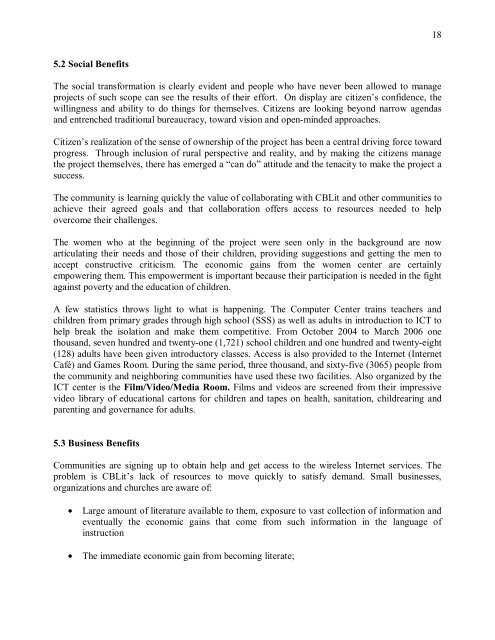Wireless Ghana: A Case Study
Wireless Ghana: A Case Study
Wireless Ghana: A Case Study
You also want an ePaper? Increase the reach of your titles
YUMPU automatically turns print PDFs into web optimized ePapers that Google loves.
18<br />
5.2 Social Benefits<br />
The social transformation is clearly evident and people who have never been allowed to manage<br />
projects of such scope can see the results of their effort. On display are citizen’s confidence, the<br />
willingness and ability to do things for themselves. Citizens are looking beyond narrow agendas<br />
and entrenched traditional bureaucracy, toward vision and open-minded approaches.<br />
Citizen’s realization of the sense of ownership of the project has been a central driving force toward<br />
progress. Through inclusion of rural perspective and reality, and by making the citizens manage<br />
the project themselves, there has emerged a “can do” attitude and the tenacity to make the project a<br />
success.<br />
The community is learning quickly the value of collaborating with CBLit and other communities to<br />
achieve their agreed goals and that collaboration offers access to resources needed to help<br />
overcome their challenges.<br />
The women who at the beginning of the project were seen only in the background are now<br />
articulating their needs and those of their children, providing suggestions and getting the men to<br />
accept constructive criticism. The economic gains from the women center are certainly<br />
empowering them. This empowerment is important because their participation is needed in the fight<br />
against poverty and the education of children.<br />
A few statistics throws light to what is happening. The Computer Center trains teachers and<br />
children from primary grades through high school (SSS) as well as adults in introduction to ICT to<br />
help break the isolation and make them competitive. From October 2004 to March 2006 one<br />
thousand, seven hundred and twenty-one (1,721) school children and one hundred and twenty-eight<br />
(128) adults have been given introductory classes. Access is also provided to the Internet (Internet<br />
Café) and Games Room. During the same period, three thousand, and sixty-five (3065) people from<br />
the community and neighboring communities have used these two facilities. Also organized by the<br />
ICT center is the Film/Video/Media Room. Films and videos are screened from their impressive<br />
video library of educational cartons for children and tapes on health, sanitation, childrearing and<br />
parenting and governance for adults.<br />
5.3 Business Benefits<br />
Communities are signing up to obtain help and get access to the wireless Internet services. The<br />
problem is CBLit’s lack of resources to move quickly to satisfy demand. Small businesses,<br />
organizations and churches are aware of:<br />
• Large amount of literature available to them, exposure to vast collection of information and<br />
eventually the economic gains that come from such information in the language of<br />
instruction<br />
• The immediate economic gain from becoming literate;


